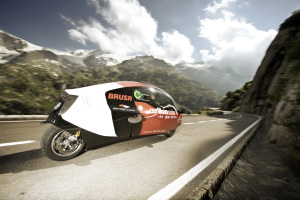Aug 13 2010
Oerlikon Solar, the world's leading supplier of thin film silicon photovoltaic (PV) production equipment, is the main sponsor of the Oerlikon Solar Racing Team participating in the Zero Emissions Race with its Zerotracer electric vehicle.
The Zero Emissions Race promotes sustainable mobility and transport, and aims to generate popular enthusiasm for the use of renewable energy sources for vehicles and set the highest environmental standards for the future. The competing teams will race around the globe in 80 days.
 The Zerotracer races through Switzerland, powered by Oerlikon Solar's thin film silicon technology.
The Zerotracer races through Switzerland, powered by Oerlikon Solar's thin film silicon technology.
“The goal of the race for Oerlikon Solar is to spread the message that there is progress in innovation for more efficient and sustainable mobility for the future,” says Jürg Henz, CEO of Oerlikon Solar. “Run by Oerlikon Solar’s innovative, Swiss engineering thin film silicon solar technology, the Zerotracer is a perfect example of how electric vehicles can be fun to drive, desirable in design and sporty in performance, all while fighting global warming.”
Mobility with zero emissions
The Zero Emissions Race is the brainchild of Louis Palmer, the first person to circle the globe in a solar-powered vehicle. Palmer’s aim with the Zero Emissions Race, which is being held under the auspices of the United Nations Environmental Program (UNEP), is to present emissions-free mobility solutions. The Zerotracer, sponsored by Oerlikon Solar under the auspices of Cleantech Switzerland, is one of these solutions. The Zero Emissions Race will start on August 16, 2010 at the United Nations office in Geneva and will continue for 80 days, heading eastward through 16 countries and passing through more than 150 cities, including Berlin, Munich, Moscow, Shanghai, Vancouver, Los Angeles, Cancun (World Climate Conference), Lisbon and Madrid. It will conclude on January 22, 2011 in Geneva.
As the main sponsor of the Swiss team, Oerlikon Solar is responsible for generating the environmentally friendly solar energy. This energy is produced with thin film silicon modules that are non-toxic materials, and powers the Zerotracer at 2,400 kilowatts/hour (kWh) for the 30,000 kilometers (km) trip around the world. The Zerotracer is the product of a four-man team of young engineers and designers who work on similar vehicles in order to fashion new mobility concepts for tomorrow. Oerlikon Solar and the team are both pioneering work in the area of environmentally sustainable thin film silicon solar technology, and in the future mobility with zero carbon dioxide emissions.
With its streamlined, futuristic shape, the Zerotracer is a combination of a car and a motorcycle. The core concept of the Zerotracer is to achieve ultimate efficiency with a unique driving experience, wrapped together in an attractive design package. Due to its superior aerodynamics and highly efficient electric drive train, the Zerotracer is able to accelerate faster than a Porsche 911. It has room for two people, and can hold its own against the world’s fastest cars with acceleration from 0 to 100 km/h in 4.5 seconds. The Zerotracer consumes 4 kW when travelling at an average speed of 80 km/h, resulting in a range of 450 km. The body weighs less than 80 kg and is made from Kevlar composite, which is also used in Formula 1 automobile construction.
“Swiss engineering excellence”
In addition to the concept of zero emissions, Oerlikon Solar is committed to Swiss engineering excellence. The Zerotracer is a demonstration of Swiss engineering ingenuity and communicates the "high tech made in Switzerland" message around the world. As the main sponsor, Oerlikon Solar makes a significant contribution to this message with environmentally sustainable thin film silicon technology from Switzerland. Technology partners Oerlikon Mechatronics supplied tailored gearbox components and Oerlikon Graziano supplied a high-torque drive system. The electric motors, gearwheels and additional components originated from Swiss technology enterprises.
“Our objective in being part of this effort is to demonstrate that a new form of mobility based on solar energy is not only possible, but in fact already suitable for everyday use,” said Henz.